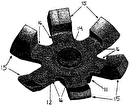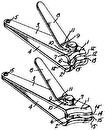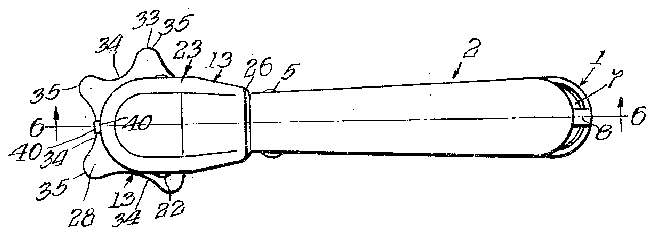
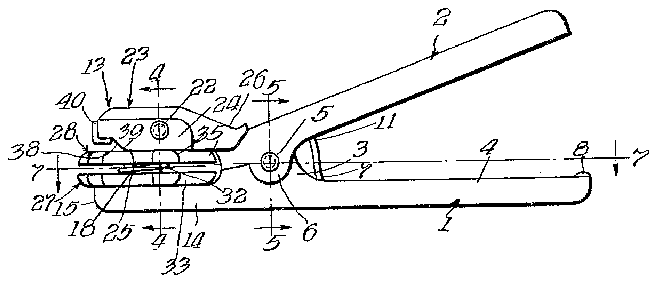
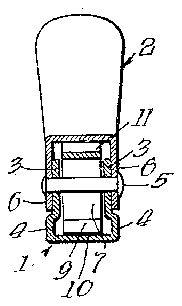
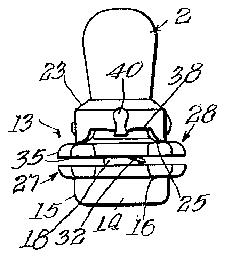
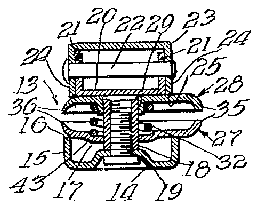
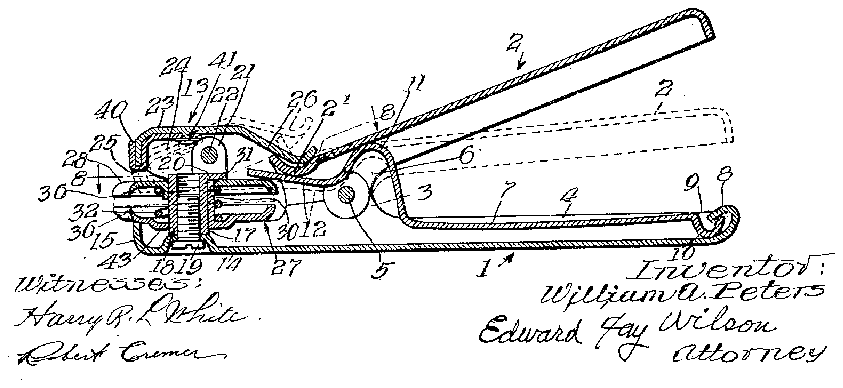
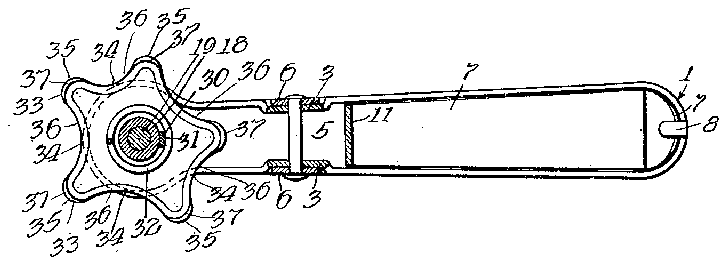
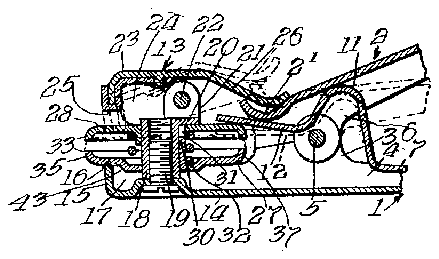
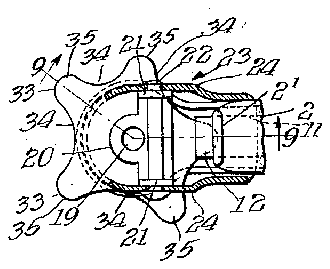
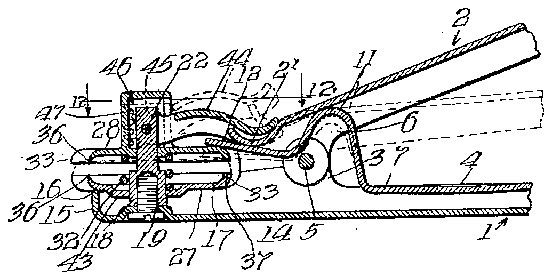
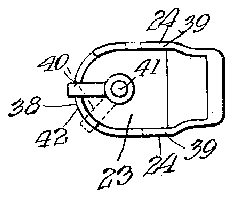
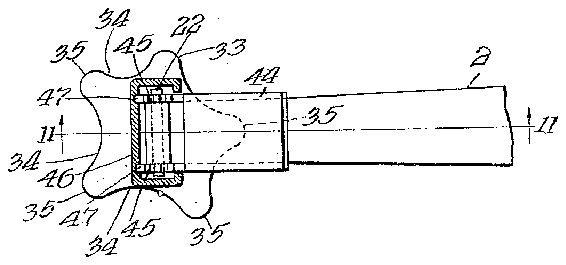
- 2handle member
- 3pair orp 11p-standing ears
- 7spring
- 12forward end
- 14extension or lower yjaw
- 16liat or horizontal edge
- 18guide member
- 19fastening screw
- 22pivot pin
- 23jaw
- 24wall
- 25points
- 26rear end
- 28upper cutter
- 29nozzle
- 31curves
- 32coiled spring
- 33peripheries
- 34re-entrantcurves
- 35outwardly extending projecting portions
- 37ng flat shoulders or contacting surfaces
- 39rovide rounded hearing or fulcrum points
- 40arm
- 42forward end
- 44lever
- 47ally disposed co-operating toothed racks
- 111forward extension
- 223upper aw member
- 841peters
- 847peters
Description
Jan. 19, 1932. W A, PETERS 1,841,847
FINGER NAL CLIP Filed July 6, 1931 2 Sheets-Sheet l Jan. 19, 1932. w. A, PETERS 1,841,847
FINGER NAIL CLIP ZU/n 5565: #MW Z @12965075 Cil tra
WILLIAM A. PETERS, OIE CHICAGO, ILLINOIS, ASSIGNOR GF ONE-HALF TO DAVID JAMES, F CHICAGO, ILLINOIS FINGER NAIL CLIP Application filed July 6, 1931.
rlhis invention relates to improvements in devices for trimming or clipping the tlnger nails, such devices commonly being called nail clippers.
The objectI ot the invention is to provide a device for this use which can be conveniently used by a person on his own finger nails or upon the linger nails ot others; which shall have a. plurality of shapes or sizes oi' cutters readily arrangeable tor use; which shall have a plurality et cutters of dilierent sizes or shapes in positions for use at all times; which shall be capable ot being arranged to especially app-ly heavy cutting pressure to specific pairs oi cutters as desired; which shall have cutting edges which are protected against being dulled by contact with each other; which shall be so arranged that very powerful cutting pressure can easily be applied for use; and which shall be licht in weight and of pleasing design.
ther features of advantage will become apparent from the following description taken in conjunction with the appended claims and the accompanying drawings torming` part et' this specification and in which Fig. l is a. top-plan view et a device embodying the invention in one form;
Fig. 2 is a side view ot the device shown in Fig. l;
Fig. B is a iront end View of the device;
Figs. 4 and 5 are transverse sections on the line 4 4 and 5 5, respectively, or" Fig. 2;
F ig. 6 is longitudinal, central, vertical section on the line 6 6 ot' Fig. l;
Fig. 7 is horizontal section on the line 7 7 of Fig. 2;
i ig. 8 is a fragmentary, substantially hori- Zontal section on the line 8 8 ot Fig. S;
Fig. 9 is a fragmentary, substantially central, longitudinal7 vertical section on the line 9 9 of Fig. 8;
Fig. 10 is a bottom plan view of one of Serial No. 548,936.
the lever members particularly showing the shiiitable fulcrum device;
F ig. ll is a fragmentary, longitudinal, central, vertical section similar to 9 but illustrating a slightly modified construction; and
F ig. l2 is a fragmentary, horizontal section on the line 12-12 et Fig. ll.
rihe device as shown in the drafw'ings comprises a base or main handle member l and a Vco-operating lever handle member 2, both termed up out ci sheet metal.
rThe base member l is provided between its ends with a pair orp 11p-standing ears 3 ising from its side walls 4 and pierced to receive a connecting pivot pin 5, the torward end of the handle member 2 being provided with depending ears 6 which are liliewise pierced to receive the pivot pin 5 and the two members l and 2 are thus pivotally mounted in the relation of handles ot a pair of pliers. These handle members are normally held separated, as shown in Figs. 2 and 6, by a. long tlat spring 7 which is arranged between the handles.
rlhe spring 7 is held in place between the handles by the engagement of a bendable tongue S at the free rear end ot the handle member l, the rear end 9 of the spring being formed int-o a hook, as shown, for engagement beneath the tongue 8. The lower part l0 ot the hook 9 forms a ulcrum upon which the spring is supported for its resilient action.
The opposite end portion of the spring is bent upwardly to form a shoulder ll for contact with the lower side oil the handle mem ber 2 just to the rear ot the pivot 5 and opera es to normally hold the handles separated, as shown.
The tree end l2 of the spring 7 extends forwardly into the head part 13 or". the device and has a function which will be described later.
rlhe head part 13 of the device comprises trl ' wall 24 pierced to receive the pivot pin a forward extension 111 ot base handle member 1, which is somewhat cup-shaped, haring a peripheral Lip-standing wall .l5 with a liat or horizontal edge 16, and forms the lower jaw member of the device. is to be noted that the side walls el ot tl e base member 1, which make this member channel shaped in cross-section extend forward and merge into wall 15 of the extension or lower Yjaw 14. This construction is very strong and light and the metal is the best form to prevent any distortion of the member by the torce applied to the cutters. rl`his lower part 1l; carries a fixed centi. cuide member l?.
As shown, the guide member comprisesI a tubular part 18 which is intfrnally screwthreaded to receive a fastening screw 19 entering through the botom of the member lll, and an upper head part 2U provided with two up-standing ear` 2l pierced to receive a horizontal pivot pin Upon the pin is pivotally mounted an upper aw member 223 which, similar to the lower jaw meml'ier, is somewhat cupwshaped, having a peripheral e2, and has a lower` edge opposed to the flat upper edge lll or" the lower j aw 15.
The upper jaw member 28 being cup or cap shaped serves to enclose and cover up the working parts between the jaws, thus presenting a smoothly finished device of pleasing appearance.
This lower edge oi the unper aw member is not fiat like the opposed edge oi'A the lower member but is Atorni-elfi and adapted to provide fulcrum points 25 for applying the cutting or operating pressure.
The pivot pin 22 is located to the rear of the center of the cutters and the iii'ilcrum or pressure points 25/ are arranged slightly in front of the center oit 'the cutters in the best relation for applying the pressure to the cutters.
The upper member' is adapted to be swmig on the pivot pin 22 by the upper handle member 2, the handle member when swung down as shown in dotted lines in 1*" g. 5, being adapted to swing the rear end 26 ot4 the jaw 23 upwardly and consequently its forward part downwardl' j.7 towards the lower jaw member. 'l`o eiiiect this movement the rear part 2G of the upper jaw member e):- tends over the forward end 2 of the handle member 2, as best shown in Fig. 6, and the two are formed to provide sliding engage ment to permit the necessary relative movement during operation. As the handle member 2 is swung down, the upper jaw is swung to the dotted position shown in Fig. 6, that is, its forward part is swung down towarfi the lower jaw member.
Between these two jaw members are arranged a pair of cutters comprising a lower cutter member 27 and an upper cutter' member 28.
These cutters are flat disk-like members centrally mounted on the central, vertical guide member 18 to rotate. The upper cutter 28 is provided with a central bearing nozzle 29 for rotation and up and down movementon the guide member 18, and the lower cutter 27 is keyed to the upper cutter for rotation therewith by key projection 8O rigid with the lower cutter and projecting up alongside of the guide member 18 and passing through a notch 3l in the inner edge ot the upper cutter 28.
Between the cutters 2T and 28 and surrounding the guide 18 is a coiled spring 32 which tends to keep the cutters separated and against the tension of which the cutters are forced toward each other for use in clipping nails.
The cutters have been described as being flat disk-lille members but their peripheries 33 are turned toward each other and are formed into a plurality of re-entrantcurves 34 ot different radii, as best shown in Figs. 7 and 8, thereby `forming outwardly extending projecting portions between the curves 31. The inwardly curved parts of the edges ot the cutters are beveled on theirI inner sides to form cutting edges 36. The outwardly extending projecting portions 35 between the cutting edges Si() are oppositely curved or rounded and the beveling is extended onto the ends of these parts thus extending the ends of the cutting edges in slightly reversed curves, but the middle portions oi these outwardly extending parts are not completely beveled; thus providing flat shoulders or contacting surfaces 37 which effectively prevent the opposed cutting edges of the cutters bruising and dulling each other in the use of the device.
The reverse curved form ot' the ends of the cutting edges prevent the leaving of uncut or unsevered parts when clipping the nails. In other words, by this means the leaving oit' snags or partly severed pieces is prevented.
The peripheral walls ot the cutters are complete and when the cutting edges are pressed together, the space within the cutters is a closed space in which the clipped oli' portions of the nails are held until the handle 2 is allowed to recede from its pressed down position.
This is of advantage as the clippings can be retained in the device and deposited or re moved at will and prevents the scattering of the clippings where not desired.
As shown, the re-entrant curved parts of the cutters are of' different sizes and, preterably, are five in number, as shown, so that one is setdirectly opposite to the handles or on the end of the device, the next adjacent curves will be set one on each side and in front of the pivot pin 22, the cutting edges of these two side portions being thus located about half way between the forward cutting edges and the pivot pin.
In the use of the device, either the cutting edges at the outer end of the device can be used or the cutting edges at either side.
As explained before, the upper' jaw 23 is peculiarly formed at its periphery which is opposed to the periphery of the lower jaw. This peculiar formation consists in cutting away the forward part of this periphery as shown at 38 to provide rounded hearing or fulcrum points 39, one on each side substantially midway between the pivot pin 22 and the forward edge of the aw 23. These bea-ring or fulcrum points bear on the upper cutter and force it with great power towards the lower cutter to accomplish the cutting action.
As the upper jaw 23 is cut away as describer it will not bear on the forward part of the upper cutter when it is desired to use the forward pair of edges. For the purpose of arranging the device so that the force can be applied directly to the forward pair of itting edges, there is provided a movable abutment consisting of an arm 40 pivotally mounted on the underside of the upper jaw at el, Fig. l0, and arranged to swing around the forward end 42 of the jaw member 23 and adapted to be swung to a mid-position, as shown in full lines, Fig. l0, when it is desired to use the end cutting edges and to be swung around to one side or the other, as shown in dotted lines, Fig. l0, out of the way when it is desired to use the side cutting edges.
The several cutting edges are madeY of different radii for use on different sizes of nails and may be made of various shapes to produce trimmed nails of different shapes as fashion may dictate.
ris best shown in F ig. 7, the sides of the lower handle member neXt the pivot 5 are formed inwardly to receive the ears on the upper handle member and present a neat `linished appearance. It should be noted that the edges of the handle members are formed inwardly toward each other, for the purpose cf providing a maximum of rigidity to withstand the strains of use, and to present a smooth and iinished appearance.
rI`he turned in edges of the lower handle member prevent the lateral displacement of the spring 7.
The forward end 12 of the spring 7 is extended over the rear edge of the cutters and when the device is operated to close the cutters, this forward end of the spring tends to apply a strong yielding pressure on the rear dge of the upper cutter to balance the cutving pressure applied by the upper jaw and has prevent any cramping of the upper cutter upon the central guide member.
The central portion of the lower cutter' 27 is depressed as shown at 43 to form a seat for the spring 36 and the upper end of the spring` surrounds the nozzle 29 on the upper cutter.
The modiiiedstructure shown in Figs. ll and l2 is only modified as regards the means for applying` the cutting pressure. In this form the upper jaw member 23 is replaced by a lever 44, the rear portion ofwhich is engaged by the upper handle member as in the form described, but the forward end is formed intotwc segmental toothed gears et central'to the pivot 22, and the upper cutter 28 carries a boX-like central housing d6 formed on its inner wall with vertically disposed co-operating toothed racks 47. It will readily be understood that when the handle 2 is pressed down or toward the other, the upper cutter will be forced toward the o posite cutter through the medium of the segmental gears and racks. In this modified form, the main spring 7 acts in the same manner as before to apply a cutter closing pressure back of the pivot pin 22, as before.
As many modifications of the invention will readily occur to those skilled in the art, I do not limit or confine the invention to the specific details of construction herein shown and described.
I claim:
l. In a device of the kind described, a lever formed up out of sheet metal and provided with a handle at one end and a cutter support at the other end, a second handle pivoted to the firsthandle between the support and the handle part, a disc cutter on the support, the support formed with an upstanding rim, having a flat edge for contact with the disc cutter near its periphery as and for the purpose specified.
2. In a device of the kind described a channel shaped combined handle and cutter support member, the flange of the member beingcontinuous around the cutter end and forming a circumferential support for a disc-like cutter.
3. In a device of the kind described a pair of disc-like cutters, means for moving one cutter from and toward the other, a cup-like support for one of the cutters having a circumferential rip-standing edge for contact with the cutter, as and for the purpose specified.
4. In a device of the kind described, a pair of disc-like cutters, a rigid guide post upon which the cutters are mounted, and interengaging guide parts on the cutters for retaining them in circumferential register.
5. In a device of the kind described, a pair of disc-like cutters, a cup-like support for one of the cutters, a guide post rising from the center of the cup, a screw projecting through the bottom of the cup, and rigidly clamping the post in position, the bottoni of the cup dished inwardly to shorten the post and to sink in the head of the screw.
6. In a device of the kind described, a
pair of hand levers, a pair of opposed cutters, the hand levers pivoted together between their ends, the cutters supported on one of the levers, a cap-like lever pivotally mounted above the cutters, the opposite hand lever formed and adapted for operative engagement with the cap-like lever to force the cutters together when the handles are forced toward each other.
In witness that I cla-im the foregoing as my invention7 I aix my signature this 2nd day of July, 1931.
WILLIAM A. PETERS.

